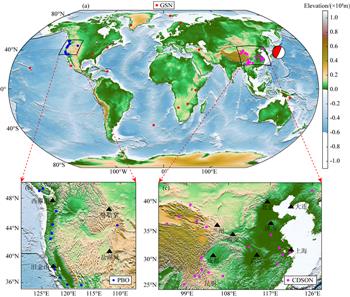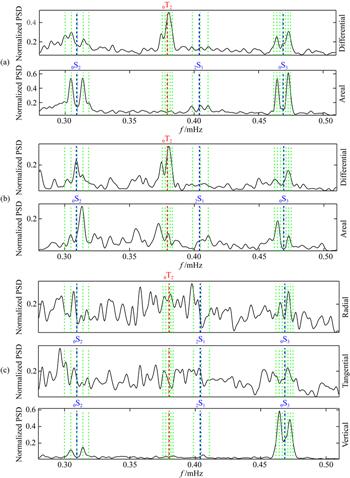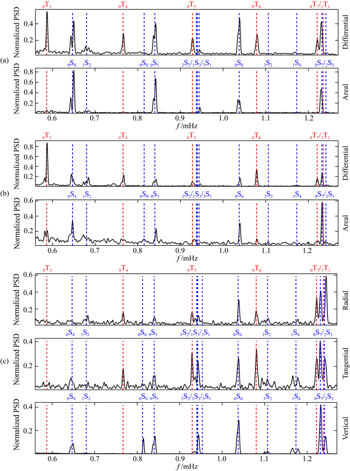| 用钻孔应变数据探测2011年日本Tohoku大地震激发的低频地球环型自由振荡及其谱峰分裂 |
| |
| 引用本文: | 张赓, 徐建桥, 陈晓东, 张凌云, 孙和平, 龚立卓. 2024. 用钻孔应变数据探测2011年日本Tohoku大地震激发的低频地球环型自由振荡及其谱峰分裂. 地球物理学报, 67(4): 1383-1397, doi: 10.6038/cjg2023Q0551 |
| |
| 作者姓名: | 张赓 徐建桥 陈晓东 张凌云 孙和平 龚立卓 |
| |
| 作者单位: | 1.中国科学院精密测量科学与技术创新研究院,大地测量与地球动力学国家重点实验室,武汉 430077;中国科学院大学,地球与行星科学学院,北京 100049;2.中国科学院精密测量科学与技术创新研究院,大地测量与地球动力学国家重点实验室,武汉 430077;3.华北理工大学矿业工程学院,河北唐山 063210 |
| |
| 基金项目: | 中国科学院战略性先导科技专项(B类)(XDB41000000), 国家自然科学基金(42174101, 42192535, 41974023, 42004075), 湖北珞珈实验室专项基金(S22H640201)资助 |
| |
| 摘 要: | 
地震激发的地球自由振荡中,环型自由振荡(特别是低频环型自由振荡)的精确探测相比于球型自由振荡更加困难.环型自由振荡对SH波速度结构更加敏感,能更好地监测走滑断层运动,因此精确估算环型自由振荡的谱峰参数可为地球内部大尺度SH波速度结构和大地震的震源机制提供更强约束.本研究利用2011年日本Tohoku地震后四分量钻孔应变仪的观测资料,提取了该地震激发的1.3 mHz以下低频环型和球型自由振荡信号,与STS-1宽频带地震仪的结果相比较,发现四分量钻孔应变仪对1 mHz以下的环型自由振荡具有更强的探测能力.
本研究还采用频率域自回归方法精确估计了0T2—0T6的简并频率,结果与PREM模型理论值相差非常小,平均相对误差仅为2.52×10-4.此外还用钻孔应变仪观测资料探测到了0T2谱峰分裂现象.研究结果表明,钻孔应变仪能有效探测到大地震激发的低频地球环型自由振荡信号,可为地幔大尺度各向异性结构研究提供高质量的基础数据.

|
| 关 键 词: | 环型自由振荡 钻孔应变仪 Tohoku地震 简正模谱峰分裂 STS-1地震仪 |
| 收稿时间: | 2022-07-11 |
| 修稿时间: | 2023-02-19 |
| 本文献已被 万方数据 等数据库收录! |
| 点击此处可从《地球物理学报》浏览原始摘要信息 |
|
点击此处可从《地球物理学报》下载免费的PDF全文 |
|



